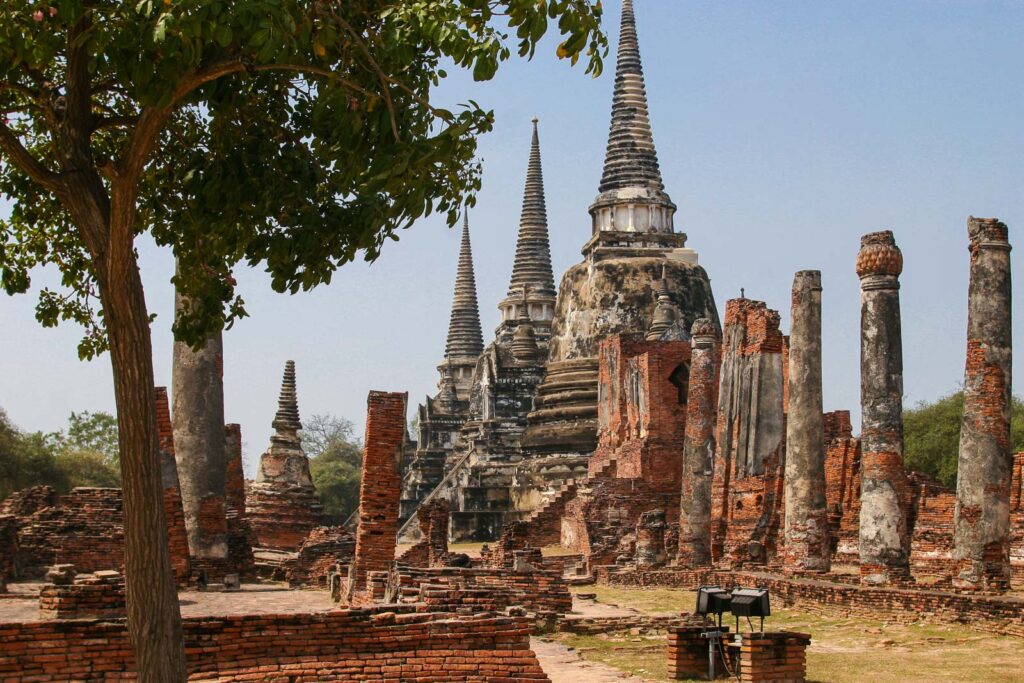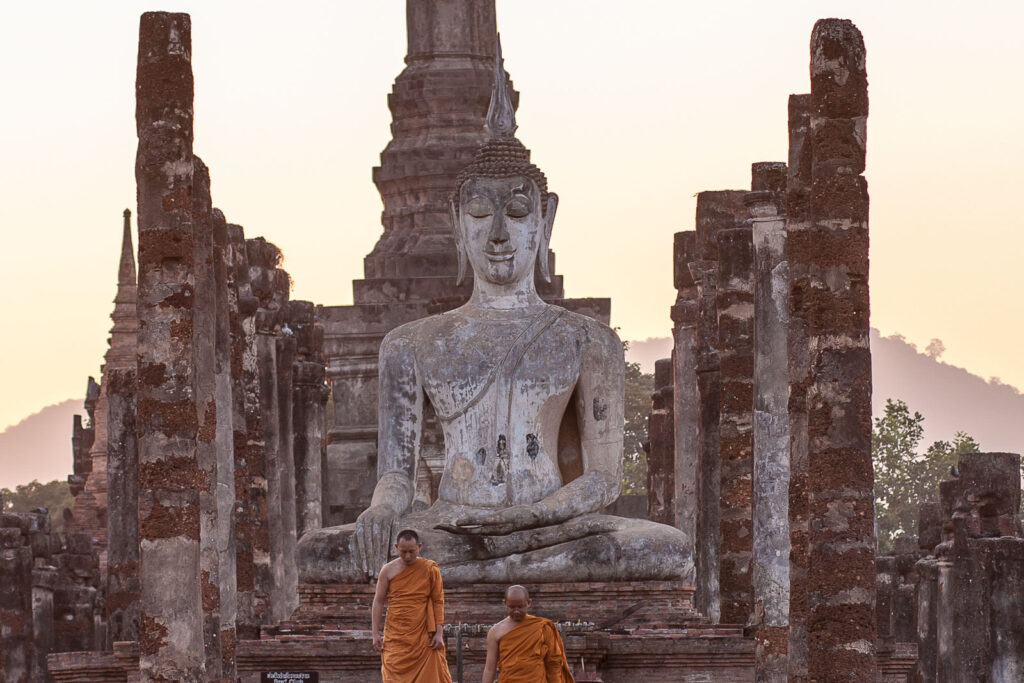Text & Photo : Antti Helin
Besides its fabulous beaches Thailand has a lot to offer for travelers interested in culture and history. So here they are, the top sights of Thailand from mythical ruined cities and otherworldly temples to one of Asia’s most beautiful old towns.
Grand Palace and Wat Phra Kaew – Here Lives the Soul of Thailand

The sight is spellbinding. The spires of Bangkok’s Grand Palace and adjacent Wat Phra Kaew temple glow golden as the sunlight is reflected from the thousands of tiny mirror pieces covering the walls of the buildings.
Step inside the main temple, and there he sits, atop a high glimmering throne, the Emerald Buddha, Thailand’s most holy artefact. It is said that the soul of the whole country resides in this statue. As long as the Emerald Buddha sits in his throne, Thailand will flourish.
Grand Palace is located in Bangkok’s royal heart, the Rattanakosin, and almost next door you will find two other highlights of the capital, Wat Po and the National museum. Wat Po is famed for its majestic reclining Buddha statue, and National Museum houses one of the largest and most comprehensive collections of Southeast Asian art, making it an excellent introduction to Thai history, art and craft.
Ayutthaya and the Buddha Statue that Has Seen it All

The roots of a big banyan have engulfed the head of a Buddha statue under its embrace. The head doesn’t seem to mind, its smile is wise and soothing, like saying that no matter what happens, life will go on.
That statue, in front of Wat Mahathat’s ruins, is one of the most enchanting sights of Ayutthaya. It has seen a lot, the glory days of Ayutthaya, the former capital of Siam, and its destruction by the invading Burmese army in 1767. When the Burmese left, only ruins and fantastic legends remained of the city that had flourished for over 400 years.
The stories of old Ayutthaya are among the most loved in Thailand, and an endless source for Thai movies, which blend seamlessly history and sword wielding fantasy.
After the sacking of Ayutthaya, the Thais established their center of power in present day Bangkok.
You can visit Ayutthaya as a day trip from the capital, but there is so much to see and experience, it is better to stay overnight. That way you can see the ruins in the beautiful golden light of late afternoon and early morning. And maybe enjoy a few more precious moments under the warm and wise smile of that old statue embraced by the banyan tree.
Sukhothai – Meet the Oracle of Thailand

Even long before Ayutthaya, the Thais settled their first kingdom in Sukhothai, which lies in its sublime solitude in the central plains of Thailand. Sukhothai is considered as the place where the kingdom of Siam was originally coined together by the wise and rightful king Ram Khamhaeng.
One of the highlights of Sukhothai is Wat Si Chum, a temple, where a 15-meter tall Buddha statue is sitting cross legged in deep meditation. Many consider it one of the most beautiful statues in Thailand, yet it is also one of the most mystical.
It was used as a kind of an oracle by the kings of Sukhothai, or so the local legend says. The king would walk up a secret staircase behind the head of the statue and it sounded like the statue itself was talking words of wisdom to the crowds.
The original, finely decorated staircase is closed to the public, but a copy has been built in the Sukhothai National Museum.
Sukhothai is located about halfway between Bangkok and Chiang Mai. The slightly out of the way location has kept it delightfully sedate. In the early mornings and late evenings, you can feel like the only visitor amongst the ruins. And maybe, if you listen carefully, you can hear the Delphian Buddha statue to talk to you too.
Chiang Rai in Black and White

The northernmost city of Thailand, Chiang Rai, is home to two mesmerizing buildings that will leave you touched. Chiang Rai’s White Temple and Black House are like opposite yin and yang forces to each other. Both are the works of contemporary artists.
Chalermchai Kositpipat has built his masterpiece Wat Rong Khun on shining white and decorated it from the outside all over with fantastic carvings. The inside is even more arresting. Instead of Buddhist stories and folk tales, the murals depict superheroes and other popular culture characters waging the war of good against evil.
On the opposite side of the city is the Baandam Museum, The Black House. Artist Thawan Duchanee has filled his impressive, traditional style teak wood buildings with menacingly gloomy collection of skins, bones and teeth of a wide array of animals as if wanting to say, that we can’t rely on heroes only, but we all need to change right now the way we live, or the end is night.
Nan’s Romantic Temple

A tattooed man with hipster-like mustache whispers something to a woman who looks at him charmingly. Does the man confess love, or what is in his mind? The enigmatic temple mural has earned the remote northern town of Nan the nickname, the City of Whisper.

The Whisper is the most famous of Wat Phumin’s temple murals, but the other pictures are as fascinating, vividly depicting everyday life of this remote small town in the late 19th century. A painting representing a remarkable beauty has been named the Madonna of Nan.
In many paintings, both men and women smoke thick Burmese-type cigars. Smoking was once a good way to flirt. The man could ask the woman for a fire, which the woman bowed to offer from her own tobacco. This gave the man a good opportunity to tell the woman about his feelings.
Situated close to the Laotian border, surrounded by mountains, little visited Nan is one of the most peaceful destinations in Northern Thailand. Even the residents of Nan themselves say that they live in the middle of nowhere. And that is one good reason to travel to Nan. Here you can experience for yourself the authentic rural Thai way of life – both in the 19th and 21st century. You might even conclude that not so much has changed.
Phraya Nakhon – The Cave of the Kings

First, you have to trek 45 minutes up the limestone mountain. The way is tough, but the reward is more than worthwhile. Even three Thai kings have sweated their way up. Or who knows, if they were carried up in a palanquin.
Finally, you will reach a large cave of cathedral like proportions. In the middle of the cave, in the solemn darkness of the early morning, sits a graceful, blue-roofed pavilion.
Then, the magic happens. The first rays of morning sun reach the opening of the collapsed cave roof, and slowly, little by little, the sun’s rays paint the pavilion with heavenly light.
After the spectacle it is time to have a closer look at the pavilion. In the middle of it stands a small statue. It depicts King Rama V, who built the pavilion in 1890. The king was particularly fond of the cave, which he visited a total of five times. Kings Rama VII and Rama IX have also paid a visit.
Phraya Nakhon cave is located in the Sam Roi Yot National Park, which is best visited from the popular beach resort of Hua Hin, also known for its own royal roots.
Phuket Town – Wild Vegetarians and Beautiful Old Buildings

Surprisingly few people know that Phuket is not only a beach destination, but also the home of one of Southeast Asia’s most beautiful old towns. Phuket Town’s century-old Sino-Portuguese mansions and decorated shop-houses are reminders of the time when Phuket was a wealthy tin mining island, long before the holidaymakers arrived.
Nowadays many of the atmospheric old houses have been turned into cozy cafés, restaurants and art galleries. Based on a photo hanging on the wall of China Inn Café, even the Swedish royals have visited the place! Despite the occasional royals, life in the old town goes on its own rhythm. It is estimated that just a fraction of all the holidaymakers visiting the island will pay a visit to the Old Town.
Phuket town is at its most fascinating in October, when the Vegetarian Festival takes place. And no, unlike the name might suggest, the festival is not about the health benefits of eating veggies but a wild and extreme celebration, where the participants go into deep trance, and pierce their bodies with swords, needles and all other kind of sharp objects and walk on fire.
The festival is believed to be have been introduced by a traveling Chinese opera and celebrates the Chinese community’s belief that abstinence from meat, alcohol, sex and telling lies, among others, will help them attain good health and peace of mind. This festival is definitely not for the faint-hearted.
Share




